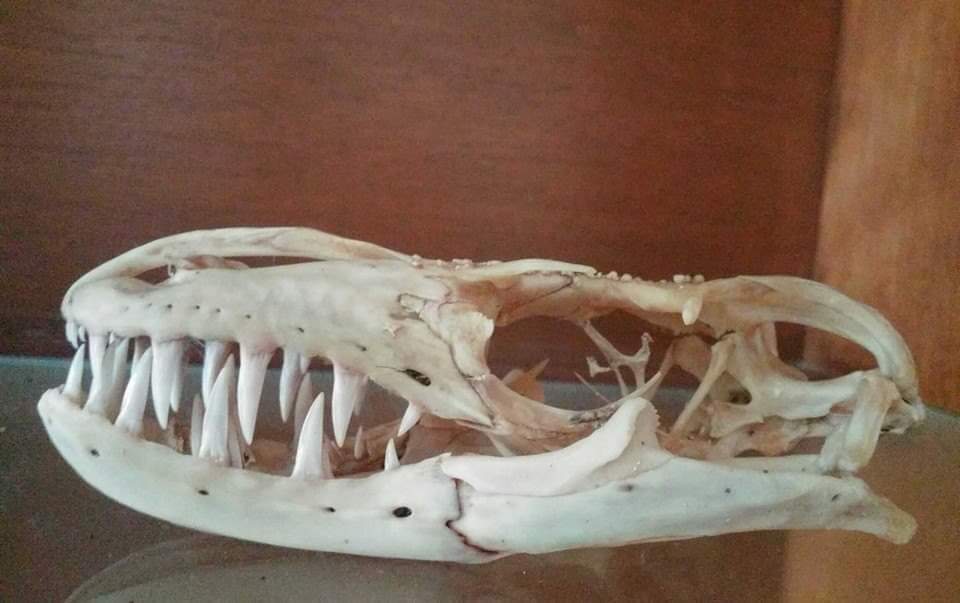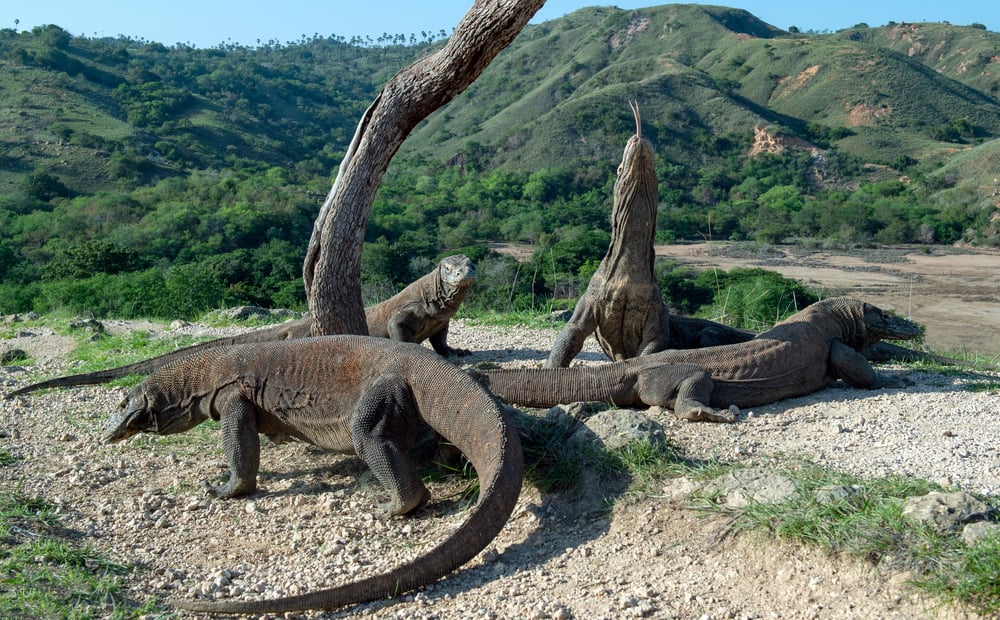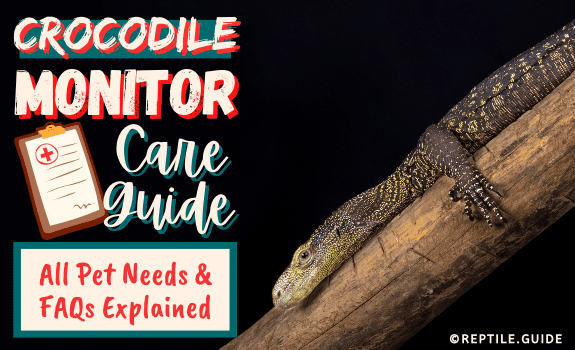The crocodile monitor lizard (Varanus salvadorii) is a large, predatory lizard endemic to New Guinea.
Though this species is fairly common in the pet trade, they’re – like most monitors – quite a handful to take care of!
Young monitors may look cute at first but quickly grow into large, active lizards that can rival even the mighty Komodo dragon (in terms of length, but not mass).
It’s easy to see why keepers are attracted to these fascinating and beautiful animals, but it’s also vital to stress that these lizards are NOT suitable for beginners.
They have a nasty bite, and a reputation for unpredictability.
Because of this, keepers should be well-accustomed to large, potentially dangerous lizards before bringing home a crocodile monitor.
In This Article
What You’ll Learn
In this article, you’ll learn all about the crocodile monitor and its care requirements, including:
- Enclosure setup (and size)
- Temperature and humidity
- How (and what) to feed your lizard
- Information about handling large lizards
We’ll also answer key questions about the species, like:
- Are crocodile monitors venomous?
- How big do crocodile monitors get?
- Do crocodile monitors make good pets?
…and much more!
Crocodile Monitor Background Information
Crocodile monitors are – as their name suggests – members of the monitor lizard family (Varanidae). Monitor lizards are native to Africa, Asia, and Australasia.
This group includes some of the largest of all lizard species, like the Komodo dragon. Monitors typically have long tails, long necks, and high activity levels.
Other names for crocodile monitors (Varanus salvadorii) include Papuan monitors, Salvador’s monitors, and Salvadori’s monitors.
Description
Crocodile monitors are typically dark green with rings of ornate yellow speckles. Their delicate pattern gives them a somewhat “painted” appearance.
They’re long and slender lizards, with the longest tail of all monitors (about 45 inches).
Crocodile monitor skulls are longer than those of their closest relatives, giving them an almost crocodilian appearance.
Within their long snouts, these lizards have long, sharp teeth, which adds to the crocodile-like face.
Since they’re lizards, these reptiles are only distantly related to crocodilians.
Fun Fact: Crocodiles and alligators are more closely related to birds than to other reptiles.
Crocodile Monitors In the Wild
Crocodile monitors inhabit the forests of New Guinea. They’re endemic to this region – meaning that you won’t find them anywhere else.
Crocodile monitors are highly arboreal. Their long, prehensile tail and sharp claws make them natural climbers, and even large specimens often climb high up into trees.
On the ground, these lizards are fast, agile predators. They use their fang-like teeth to snare a range of fast-moving prey, including birds and small mammals.
Fun Fact: Some indigenous peoples of New Guinea claim that this lizard gives off a warning call when crocodiles – the top predators of New Guinea’s swamps and rivers – are nearby.
Conservation
The IUCN Red List of Threatened Species lists the crocodile monitor as a species of “Least Concern”. This means that scientists don’t believe it’s at immediate risk of extinction.
Agricultural activity is a proven threat to this species.
As in many other regions worldwide, New Guinea forests are being increasingly logged and replaced with monoculture crop plantations.
These areas provide relatively poor habitat for most species, resulting in lower biodiversity.
Local indigenous peoples harvest crocodile monitors on a small scale for their skins and meat. Some lizards also get exported overseas for pet collectors.
Most captive crocodile monitors are wild-caught, though it’s possible to breed these animals in captivity.
Are Crocodile Monitors Venomous?
“Venomous” animals use proteins in their saliva – usually secreted by specialized glands – to kill or subdue their prey.
While all vertebrates secrete a range of complex salivary proteins, venomous animals specifically use these as a technique to aid predation.
Crocodile monitors are NOT venomous, though they still have one of the nastiest bites of all lizards.
One death has been reported in New Guinea, where a woman sadly died following an infected crocodile monitor bite.
Crocodile monitor teeth are unique among monitor lizards. They’re large, sharp, and sturdy – adapted to impale fast-moving prey.
These teeth make this one of the most dangerous lizard species, despite the lack of venom.

Crocodile Monitor Size
Crocodile monitors are among the longest of all lizards. The crocodile monitor size makes them probably the largest species you are likely to see in the pet trade.
In the wild, people sometimes report seeing 12-foot individuals, though the largest verified specimen measured eight feet.
Captive specimens are typically a bit smaller, but still exceed six feet with ease.
The sheer size of these lizards is enough to discourage all but the most committed of reptile collectors.
Up to two-thirds of this impressive length is made up by the monitor’s tail.
It’s also important to note that a crocodile monitor baby will grow quickly – about two inches per month.
Once you have a full-grown crocodile monitor you’ll need to make sure that you can provide it with plenty of space to bask, climb and even swim.

Caring for a Crocodile Monitor
The crocodile monitor is not a pet for inexperienced reptile keepers.
These enormous lizards require more space than most hobbyists can realistically provide.
Moreover, croc monitors can be dangerous due to their nasty bite and have a long list of care requirements.
Very few keepers are able to commit to caring for a lizard of this size for its entire lifespan (which can be up to 20 years).
With that disclosure out of the way, let’s take a look at what you’ll need to keep this species successfully.
Enclosure Setup
The enclosure setup is one of the trickiest parts of taking care of these large lizards due to their space and enrichment requirements.
Because crocodile monitors are partially arboreal, they need lots of vertical and horizontal space to keep them happy.
In fact, most croc monitor enclosures are taller than they are wide or long.
For this reason, we recommend having a full room, or a section of a large room, entirely dedicated to their enclosure space.
If you bring home a hatchling, you can house it in a 40-gallon enclosure for the first little while.
But, as mentioned above, monitors grow rapidly and will soon outgrow their initial home.
Once they start getting closer to adulthood, we recommend the following enclosure dimensions:
- Baby crocodile monitor – 4′ wide x 4′ long x 6′ tall
- Juvenile crocodile monitor – 8′ wide x 8′ long x 10′ tall
- Adult crocodile monitor – 10′ wide x 18′ long x 12’tall (or larger)
Keep in mind that these are only the minimum requirements. Your croc monitor will never complain about having too much space and the more you can give them the better.
It’s unlikely that you’ll find many containers of this size so you’ll likely have to create a custom-size enclosure or have one tailor-made.
The inside should offer plenty of space for the lizard to climb.
You can use tree trunks, artificial or natural rocks, wooden platforms, and stairs to create vertical spaces for your pet to explore.
Also incorporate a hide that’s raised above the ground for your lizard.
Monitors spend a lot of time in the water – some even sleep in the water!
This means that you’ll need to provide them with a large enough tub so that they may submerge and maybe even swim around.
Generally, we don’t recommend keeping more than one monitor lizard per enclosure due to their aggressive nature.
Even when attempting to breed them, it’s best to keep the female and male in separate enclosures where they can see one another but they can’t start a conflict.
Substrate
You can use many natural materials, like moss, soil, and woodchips, as a substrate for the enclosure.
These monitors will need an enormous amount of substrate to fill their enclosure.
The purpose of the substrate is to help your enclosure to retain humidity. It also serves to absorb waste and keep the enclosure clean.
Substrate also provides padding for those lizards that like to jump down from their vertical perches and enrichment for digging.
The main thing to keep in mind is that the substrate should retain enough moisture to maintain optimal humidity levels.
It’s also important to ensure that any substrate you use is affordable (as you’ll need to replace it often). Ensure that it’s also non-toxic to reptiles.
Humidity
Crocodile monitors require an environment of 70% humidity or more to mimic their tropical forest habitat.
You’ll need to invest in an automated misting system in order to achieve this in such a large enclosure.
These monitors also require a large pond or tub to soak in. Though individual personalities vary, most crocodile monitors soak or swim quite often.
This will provide additional behavioral enrichment and can also help with shedding.
Note that you’ll need to replace the water on a regular basis to avoid bacteria growth.
Lighting and Temperature
Provided that you live in a warm enough climate, you can keep your monitor lizard outside in natural sunlight for at least part of the year.
If you choose to do this, it’s VITAL that you build a custom outdoor enclosure to prevent your monitor from escaping into the wild.
We recommend consulting with a professional company in order to do this effectively.

Image credit: u/indicator_species (Reddit.com)
When indoors, you must provide them with UV (that’s UVA and UVB) basking lights as you do with your other reptile pets.
Make sure that you give your lizard a warm basking area (110-120 °F) and a cooler area of the tank (91-95 °F) to aid with thermoregulation.
At night, the lizards prefer a slight temperature drop (low 71-75 °F) which mimics their natural home environment.
Feeding
Crocodile monitors are voracious predators and feed on a range of prey in the wild. Scientists believe that mammals and birds make up most of their diet.
In captivity, they require as diverse a diet as possible to maintain health.
Raw chicken, along with whole rats, mice, and rabbits all make good staples for fully grown monitors.
Smaller individuals may take rats or mice, along with quail. You can also offer fish on occasion, along with other treats like (shelled) hard-boiled eggs.
As with all reptiles, you should thoroughly defrost frozen prey before offering it to your crocodile monitor.
Hatchlings will happily eat a combination of appropriately-sized rodents and insects. Good choices include dubia roaches, large crickets, and giant mealworms.
Adult crocodile monitors require feeding twice per week.
Young monitors (juveniles and hatchlings) require feeding more often – around every other day or 3-4 times per week.
During crocodile monitor feeding, take care to avoid injury, as they can be aggressive feeders.
We recommend using a set of long feeding tongs as it’s ESSENTIAL to keep your hands well out of reach of the monitor’s powerful jaws!
This leads us to the issue of safe handling, which we’ll discuss in the following section.
Safe Handling
The fact is there’s NO safe way to handle these large, unpredictable animals.
You can socialize and train them to become accustomed to a keeper’s presence.
However, we don’t recommend trying to handle these lizards under any circumstances.
Perhaps the only time that you may need to handle them is to administer veterinary care, in which case you should consult a professional reptile vet.
Remember: the crocodile monitor’s bite is extremely dangerous and can even be fatal.
Enrichment
For these active lizards, behavioral enrichment is an essential part of good husbandry.
We recommend the following enrichment ideas for this species (but creativity will help to keep your lizard on its toes!):
- Provide a large pond for soaking and swimming.
- Ensure that your monitor has at least a couple of hides – one elevated above ground.
- Provide ample climbing opportunities like trees, large tree branches, shelves, or other custom-built structures.
Do Crocodile Monitors Make Good Pets?
Crocodile monitors are extremely dangerous animals, and DON’T make good pets.
A select few keepers can keep them successfully, but this requires decades of experience (and nerves of steel).
Not only can they deliver a nasty bite, but these are also among the most physically active of all lizards.
This fact means that they’ll require a VERY large enclosure (relative to other lizards).
Fun Fact: Crocodile monitors possess a highly adapted respiratory system. Unlike many other lizards, they can breathe effectively whilst running. This is thanks to a complex mechanism similar to the mammalian diaphragm.
If you’re looking for a monitor lizard that is easier to handle, we recommend the Savannah monitor or Ackie monitor.
These small monitors – while still a big commitment – are far easier to deal with overall due to their small size.
Check out our list of the top five best pet monitor lizards for more species to choose from.
If you’re looking for a large, powerful, and equally beautiful lizard that’s not a monitor, an Argentine tegu could be a better choice.
These lizards are still by no means recommended for beginners, but they have (in our opinion) all of the pros of a croc monitor without the giant teeth and nasty temperament!
What do you like about crocodile monitors? Let us know in the comments.
